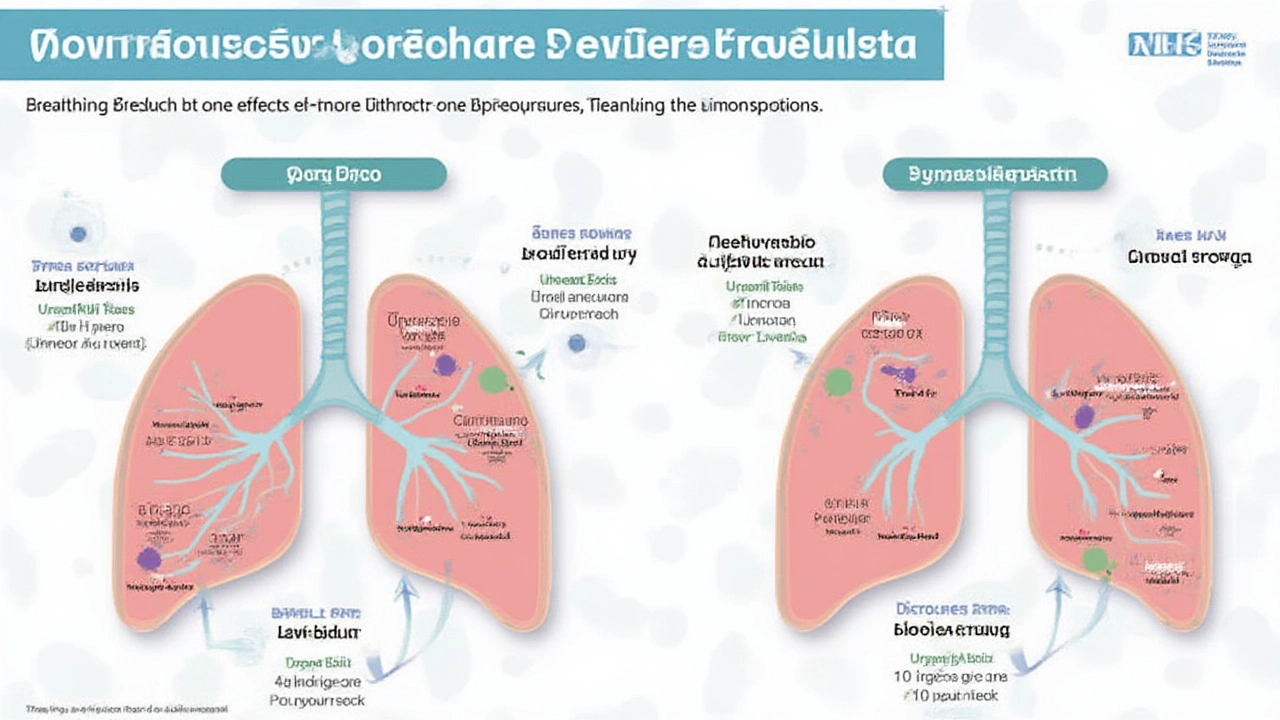If you’ve ever stood in the pharmacy aisle caught between Breo and Symbicort, you’re not alone. These inhalers might look similar on your shelf, but what’s inside and how they act on your lungs tell two pretty different stories. The debate isn’t just about brands — it’s about getting the right control over those tough asthma or COPD flares, and sometimes even just making the day less of a struggle.
What Goes Inside: Ingredients Face-Off
Let’s break it down. Breo Ellipta paves its way with two main stars: fluticasone furoate, a corticosteroid that tames inflammation, and vilanterol, a beta-agonist that opens up airways like a secret high-speed lane. Symbicort, on the other hand, mixes budesonide (another corticosteroid) with formoterol, a beta-agonist as well. Sounds similar? In some ways, yes. They both aim to reduce swelling and relax those constricting muscles in your lungs so air can move easier. But dig a little deeper and you’ll see, these combos aren’t twin siblings — more like cousins who play on the same team, but with distinct playing styles.
Why does this matter? The corticosteroids themselves pack slightly different strengths and durations. Fluticasone furoate in Breo is long-acting and a bit stronger dose-for-dose, which is why Breo only needs a single daily puff, while Symbicort relies on two doses a day to really hit its stride. And the beta-agonists? Vilanterol (Breo) lasts all day, whereas formoterol (Symbicort) acts quick and sticks around for about 12 hours. This difference means some people swear by Symbicort, especially when relief is needed fast, like after climbing stairs or walking in the cold.
If you want to see the details side by side, here’s a quick table:
| Brand | Corticosteroid | Beta-Agonist | Onset | Duration |
|---|---|---|---|---|
| Breo Ellipta | Fluticasone furoate | Vilanterol | Slow (1-2 hrs peak) | 24 hours |
| Symbicort | Budesonide | Formoterol | Fast (minutes) | 12 hours |
Both inhalers avoid chlorofluorocarbons (CFCs), using newer, more environment-friendly propellants. Fluticasone is especially popular for folks with busy schedules thanks to that once-daily advantage. For people who need flexibility, or have unpredictable symptoms, formoterol’s fast action in Symbicort is like a secret weapon in your pocket. But don’t forget: neither is a rescue inhaler if an attack hits hard, so don’t swap that out!
On a practical level, the inhaler device itself also matters. Breo uses the Ellipta device, praised for being easy to use and requiring less coordination — handy for folks who get flustered by the typical press-and-breathe motion. Symbicort’s Turbohaler or Flexhaler needs you to pay attention: twist, click, inhale steady — it intimidates some at first, but you get used to it. For older adults or anyone with shaky hands, Breo’s simpler design can mean fewer missed doses.

How Often and How Much: Dosing Schedules and Tips
Imagine forgetting your medication. Most of us have done it. The beauty of Breo is that it slots nicely into your morning routine. Brush. Puff. Done for 24 hours. Symbicort, though, likes company at breakfast and dinner, since its effects wear off quicker. This can get tricky if you’re distracted or on the go, but routine wins here. There’s no “right” schedule, only what fits best into your day-to-day grind.
The official dosing for adults: Breo Ellipta comes in two strengths, 100/25 and 200/25 mcg, with one puff per day. Symbicort offers 80/4.5 and 160/4.5 mcg strengths, taken as two puffs two times per day. Sticking to that matters more than you think. Studies have shown a direct link between missed doses and increased hospital visits for asthma and COPD. Medical guidelines back up the once-daily approach as long as you’re not having breakthrough symptoms. Symbicort’s split-dose strategy can feel like more work, but some folks actually like spreading out the control instead of betting everything on a single puff.
One hack: setting alarms makes a real difference. Some people even link inhaler use to something unavoidable, like meal prep or letting the dog out. It turns the habit into autopilot rather than another item on a crowded checklist. Still, don’t stress if you occasionally forget — just get back on track the next day, and never double up.
Let’s quickly look at cost and insurance. As of 2025, both Breo and Symbicort carry a hefty price tag, but discounts and generic options for Symbicort (the formoterol-budesonide combo) can make it more accessible. Insurance plans differ wildly, so there’s no shame in calling your provider. Coupons and savings cards almost always exist on the manufacturer’s website, and it’s worth checking — a surprising number of people are overpaying out of pocket.
Here’s a handy table for a fast reference:
| Inhaler | Dosing | Common Dosages | Daily Frequency |
|---|---|---|---|
| Breo Ellipta | 1 puff daily | 100/25 or 200/25 mcg | Once |
| Symbicort | 2 puffs twice daily | 80/4.5 or 160/4.5 mcg | Twice |
If daily routines keep falling apart, or if a drug just doesn’t seem to cover those symptoms, your doctor can always rethink the plan. And if you’re wondering about a Breo alternative, there’s a whole world out there, including other combos and even new once-daily options coming to market. It’s worth browsing, especially as 2024-2025 has brought fresh inhalers with even easier schedules.

The Lowdown on Side Effects: Which Inhaler Wins for Safety?
Everyone wants relief without drama. Here’s where side effects can tilt the scales. Both Breo and Symbicort share plenty of common complaints: hoarse voice, throat irritation, mouth thrush (yes, a weird yeasty taste), and sometimes cough after using. Rinsing your mouth after each use isn’t just grandma’s advice — it really trims down the risk of thrush.
Symbicort sometimes packs a punch faster, which can mean jitters, a racing heart, or even shaking hands, especially when you first start. That’s formoterol working its magic. Most bodies adapt, but it’s startling at first, and if you’ve got a dodgy ticker, you’ll need to check with your doctor. People with high blood pressure or heart trouble might be nudged toward Breo for its calmer, slow-lane profile. But Breo isn’t innocent: rare cases see headaches, sinus pain, or muscle cramps pop up, and some folks on high doses notice their immune system drags a bit, showing up as more colds or fatigue.
For long-term use, both drugs warn about lower bone density or cataracts if taken for years, especially at high doses. Not a daily worry, but if you’re using corticosteroids for a decade, it’s smart to ask your doctor about bone scans. Another big talking point in 2025 is the connection between steroids and mood: a handful of patients mention feeling low, moody, or anxious. Always speak up if something feels off, because a quick inhaler swap might fix it.
Some find that inhaler technique can make or break the experience. Incorrect technique leads to more side effects and less relief. A tip: film yourself or have your pharmacist watch you take the inhaler. Small fixes — like really exhaling before using, or holding your breath properly after inhaling — often make a world of difference.
Rarer but important: allergic reactions (think rash, swelling, trouble breathing right after use) need emergency help stat. And anyone with a persistent cough, new hoarseness, or regular nosebleeds over weeks should check in — sometimes it’s not the inhaler, but you don’t want to guess.
Here’s the raw point: one size doesn’t fit all. Some thrive on Breo, others on Symbicort, a few bounce to something else entirely. It’s always okay to ask for a trial run — swap if you’re not happy. For some, the right inhaler is the one you’ll actually stick to day after day. The best inhaler is the one you use properly and consistently. Breathe easy, check technique, and keep the lines open with your doctor. Breathing well is the goal, not just owning an inhaler that collects dust on the shelf.


Shruti Agrawal
July 23, 2025 AT 21:25I understand how confusing inhaler choices can be and the side‑effect table really helped clarify things
Katey Nelson
July 28, 2025 AT 11:49The choice between Breo and Symbicort feels like a modern metaphor for life’s endless compromises. We stare at sleek devices, hoping the chemistry inside will grant us control over the chaos that lives in our chests. Yet the truth is that each inhaler is a tiny universe of decisions made by scientists, regulators, and insurance companies. The table you posted shows the obvious trade‑offs: once‑daily convenience versus fast‑acting relief :) . I find myself wondering whether our bodies are not merely vessels for pharmaceutical logic but also storytellers of our daily routines. When you have to remember two doses a day, it becomes a rhythm that syncs with meals, work, and the inevitable distractions of modern living. On the other hand, a single puff in the morning turns the medication into a silent promise that the rest of the day will be easier. Some people love that promise because it reduces the mental load, while others fear that a missed dose could spell disaster. The device design itself tells a tale of ergonomics and accessibility; the Ellipta’s simple click may be a gift to anyone with shaky hands, yet the Turbohaler’s precision could be empowering for those who enjoy a more engaged routine. It is fascinating how the same therapeutic goals can be pursued through such divergent paths, each reflecting a different philosophy of care. Your article even hints at the psychological side effects – the jitters, the “racing heart” – that turn a medication into an emotional experience. I appreciate how the piece doesn’t just list facts but invites us to consider how each inhaler fits into the larger narrative of our lives. In the end, the best choice might be the one that aligns with one’s personal story, habits, and the subtle ways we negotiate health every day.
Joery van Druten
August 2, 2025 AT 02:13From a technical standpoint, the main difference is the pharmacokinetics: Breo’s fluticasone furoate has a longer receptor residence time, which explains the once‑daily dosing, while Symbicort’s budesonide/formoterol requires twice‑daily administration to maintain steady plasma levels. If you’re struggling with adherence, the once‑daily schedule can be a game‑changer. Also, remember to rinse your mouth after each use to reduce the risk of oral thrush, regardless of the device.
Melissa Luisman
August 6, 2025 AT 16:37Honestly, the article’s claim that Symbicort is “faster” is oversimplified; the onset difference is clinically negligible for most patients, and the real issue is cost and insurance coverage, which often dictate the prescription more than pharmacology.
Akhil Khanna
August 11, 2025 AT 07:01Hey folks 🌟, just wanted to add that both inhalers are great but 🎉 you should also consider the feel of the device – some people find the Ellipta super easy 🙌 whereas the Turbohaler can feel a bit clunky at first. Also, never forget to check your inhaler’s expiry date – I once used an out‑of‑date one and got weird coughing 😅. Stay safe!
Zac James
August 15, 2025 AT 21:25In many countries, the availability of generic budesonide/formoterol makes Symbicort a more affordable option, while Breo’s patented formulation can be pricey. It’s worth checking local formularies before deciding.
Arthur Verdier
August 20, 2025 AT 11:49Sure, the pharma giants want you to believe the inhalers are your personal saviors, but have you considered that the real agenda is to keep you buying brand‑name products forever? 🤔 The “once‑daily” hype is just a marketing gimmick to lock you into a subscription.
Breanna Mitchell
August 25, 2025 AT 02:13Great breakdown! I’ve been on Breo for a few months and love the simplicity – one puff, and I’m done. Keep the info coming!
Alice Witland
August 29, 2025 AT 16:37Interesting read – though I’ve always thought the whole “fast vs. slow” debate is a bit overblown. At the end of the day, it’s just a puff of powder.
Chris Wiseman
September 3, 2025 AT 07:01While the article meticulously catalogs the pharmacological nuances of Breo and Symbicort, it neglects to address the sociocultural dimensions that shape patient adherence. One might argue that the very act of inhalation is enmeshed in a ritualistic performance, a choreography of breath that resonates with historical practices of medicinal inhalation dating back to the 19th‑century sanatoriums. Thus, the device’s tactile feedback, the audible click, and even the coloration of the mouthpiece contribute to a patient’s identity construction, subtly reinforcing or undermining agency. In this light, prescribing an inhaler becomes an exercise in narrative medicine, where clinicians must consider not only the molecule but the myth that surrounds it.
alan garcia petra
September 7, 2025 AT 21:25Good point, Melissa – but I’d add that consistency beats brand loyalty any day.